
Click here to download the PDF.

65 MINUTES, 52 QUESTIONS
Turn to Section 1 of your answer sheet to answer the questions in this section.
DIRECTIONS
Each passage or pair of passages below is followed by a number of questions. After reading each passage or pair, choose the best answer to each question based on what is stated or implied in the passage or passages and in any accompanying graphics (such as a table or graph).
Questions 1–10 are based on the following passage.
This passage is excerpted from George Gissing, New Grub Street. Originally published in 1891. Reardon was a newly successful author and had married, but soon found himself unable to write. Following a conversation with his wife, he takes a walk and thinks about the time just before his wedding.
1. Which choice best describes a major theme of the passage?
A) The internal battle between true love and self-doubt
B) The unequivocal joy of wedded marital bliss
C) The destructive power of encroaching poverty
D) The fear of never reaching one’s ultimate potential
2. According to the narrator, when the woman he loved learned of his feelings for her, she
A) pledged her undying affection in return.
B) dedicated herself to her maidenhood.
C) reconsidered her prior refusal of his advances.
D) wrote her own book of poetry.
3. Which choice provides the best evidence for the answer to the previous question?
A) Lines 7–8 (“Though slenderly…strong”)
B) Lines 10–11 (“She spoke…eternity”)
C) Lines 26–27 (“Amy wished…wife”)
D) Lines 33–35 (“Amy replied…fire”)
4. Which statement best describes a technique used to represent Amy’s desire to marry the narrator?
A) The narrator describes in detail her youthful enthusiasm as a major motivating factor.
B) The narrator asks a hypothetical question that is immediately refuted.
C) The narrator applauds her decision as a reflection of an inner strength that is unparalleled.
D) The narrator stresses her sincerity as proof of a dedication fostered by her maidenhood.
5. As compared with his love letters, the narrator’s book writing is portrayed as being
A) agreeable.
B) stalled.
C) fiery.
D) imaginative.
6. In describing the relationship between Amy and the narrator, the narrator highlights a distinction between Amy’s
A) desire for marriage and his readiness.
B) beauty and his common appeal.
C) conventional education and his love of language.
D) distaste for spending and his ability to write.
7. Which choice provides the best evidence for the answer to the previous question?
A) Lines 4–7 (“He thought…hand”)
B) Lines 11–13 (“In the…it”)
C) Lines 38–41 (“Latin and…hers”)
D) Lines 45–47 (“No, not…book”)
8. As used in line 40, “wanting” most nearly means
A) lacking.
B) requesting.
C) pleasing.
D) desiring.
9. The narrator uses the phrase “what happiness lurked in embryo” (lines 48–49) to present the publishers as
A) kind.
B) wealthy.
C) influential.
D) foolish.
10. What function does the last paragraph (lines 59–63) serve in the passage as a whole?
A) It expands upon the overall theme of the narrator’s never-ending love for Amy.
B) It lists the long-term effects that poverty could have on the narrator’s relationship.
C) It provides evidence that the narrator cannot support his wife by revealing his hysteria.
D) It intensifies the narrator’s growing concerns about his ability to support his marriage.
Questions 11–21 are based on the following passage and supplementary material.
This passage is excerpted from Dan Glass, “What Happens if GPS Fails?” © 2016 by The Atlantic.

Figure 1
Data Source: Pew Research Center

Figure 2
11. The main purpose of the passage is to
A) present a problem with a current technology and highlight a potential solution.
B) provide an overview of how clocks and satellites determine distance and location.
C) analyze the negative impacts of certain technologies across various industries.
D) praise developers for their ability to answer the hard questions.
12. As used in line 13, “conceived” most nearly means
A) designed.
B) understood
C) absorbed.
D) accepted.
13. The primary purpose of the question in lines 26–28 (“What if…12:00?”) is to
A) introduce a problem.
B) correct a misconception.
C) reconsider a perspective.
D) undermine an idea.
14. Which of the following best characterizes Lombardi’s attitude toward “flying clock radios” (line 26)?
A) He is confident about their ability to handle a multitude of tasks.
B) He is concerned about how they will interact with the eLoran systems.
C) He is annoyed that no one knows exactly how they work.
D) He is worried that they have no replacement systems in case of emergency.
15. Which choice provides the best evidence for the answer to the previous question?
A) Line 25 (“GPS clocks…all”)
B) Line 30 (“Nobody knows…happen”)
C) Lines 30–33 (“Since so…backup”)
D) Lines 34–35 (“The bulk…ground”)
16. As used in line 34, “bulk” most nearly means
A) dimensions.
B) mass.
C) majority.
D) totality.
17. According to John Garamendi, the reason America isn’t using the e-Loran system even though the technology is available is that
A) the system doesn’t use real time.
B) government approval takes longer than the development of the technology.
C) federal decision-makers are scared to change systems.
D) solar storms threaten the system.
18. Which choice provides the best evidence for the answer to the previous question?
A) Lines 48–51 (“Broadcast at…canyons”)
B) Lines 64–65 (“The eLoran…done”)
C) Lines 70–72 (“How do…it”)
D) Lines 73–76 (“Now is…itself”)
19. According to figure 1, which group is closest in percentage to the percentage of users 18–29 in May 2011 who got location-based information on their smartphones?
A) Ages 50+ in Feb 2012
B) Ages 50+ in May 2011
C) Ages 30-49 in Feb 2012
D) Ages 18-29 in Feb 2012
20. Which statement is supported by figure 2?
A) Less than a third of North American GPS revenue comes from the Automotive industry.
B) GPS revenues for Surveying/Mapping are less than GPS revenues for Precision Agriculture.
C) GPS devices are less important for the Aviation industry than they are for the Marine industry.
D) The Automotive and Marine industries make up a greater percentage of North American GPS revenues than the rest of the industries combined.
21. Which additional information, if presented in figure 2, would be most useful in evaluating the statement in lines 13–15 (“While GPS…system”)?
A) The total number of GPS devices sold
B) The number of individuals in each industry using GPS devices
C) The percentage of the industry that relies on the GPS devices
D) The amount of revenue in dollars for each industry
Questions 22–31 are based on the following passage.
This passage is excerpted from Craig Welch, “Fighting Over Herring—the Little Fish That Feed Multitudes.” © 2015 by National Geographic.
22. The primary purpose of the passage is to
A) discuss how the Canadian government could better address tribal and union fishing issues.
B) explain the role of herring in supporting the economy on Haida Gwaii.
C) present the catastrophic consequences that led to global herring population decline.
D) state potential causes of herring population changes and describe the resulting effects.
23. What can reasonably be inferred about the state of contemporary herring harvests?
A) North America’s herring fishermen are reaping fewer and less mature fish.
B) Pacific catches are compensating for depressed catches in Norway.
C) They have declined worldwide after swinging wildly for decades.
D) They are hard to measure and incapable of being compared to previous years.
24. Which choice provides the best evidence for the answer to the previous question?
A) Lines 2–3 (“Norwegian herring…fleet”)
B) Lines 5–9 (“Archaeologists counting…years”)
C) Lines 12–13 (“Herring populations…back”)
D) Lines 14–17 (“Washington State’s…four”)
25. The author includes the quotation “herring are a linchpin in the food chain” (line 25) to
A) describe the causes of a drastic decline in herring worldwide.
B) highlight the wide-ranging implications of changes in herring populations.
C) identify specific predators that pose a risk to herring in the wild.
D) question whether fishing has become more difficult in recent decades.
26. What is the most likely reason the author includes the “many causes” in (line 36)?
A) To detail each consequence of herring overfishing
B) To emphasize the level of uncertainty herring researchers face
C) To list the scientific methods researchers use to investigate herring populations
D) To propose a possible solution to the problems facing herring fisheries
27. As used in line 39, “stock” most nearly means
A) base.
B) bond.
C) population.
D) savings.
28. What does the author suggest about the Canadian government’s current fishing policy?
A) It is based on the assumption that herring are intended to only act as a secondary food source in Canada.
B) It allows the government to exclusively contract with union fishermen.
C) It does not allow herring fishing to occur on Haida Gwaii.
D) It is based on incomplete data on herring populations.
29. Which choice provides the best evidence for the answer to the previous question?
A) Lines 33–34 (“The herring…did”)
B) Lines 48–50 (“The Canadian…fraction”)
C) Lines 54-55 (“They didn’t…food”)
D) Lines 58–61 (“They released…views”)
30. What is a main idea of the tenth paragraph (lines 62–69)?
A) Canadian native tribes are the primary consumers of Pacific herring.
B) Other animals need to catch herring more than the people of Haida Gwaii.
C) There are many ways to cook herring that could be sold in Canadian markets.
D) Native tribes are concerned the government’s plan will negatively impact the fish that is important for the tribes.
31. The author uses the phrase “a surprising ally” in line 76 most likely to
A) draw attention to two disparate groups united in opposition against additional herring fishing.
B) emphasize the collaborative nature of herring fisheries.
C) reiterate the number of groups with a stake in the overall health of herring populations.
D) draw a contrast between adversaries that have become further estranged.
Questions 32–41 are based on the following passages.
Passage 1 is adapted from James Platt, Poverty. Originally published in 1884. Passage 2 is adapted from Will Reason, Poverty. Originally published in 1909. As societies became more industrialized and urban in the late nineteenth century, discussions arose regarding the root causes of poverty.
32. As used in line 1, “aim” most nearly means
A) focus.
B) shot.
C) gift.
D) ability.
33. In Passage 1, Platt suggests that one way a society can reduce poverty is to
A) provide in-demand technical training to citizens in need of marketable skills.
B) redistribute wealth directly from certain types of rich men.
C) teach that the benefits of budgeting outweigh the benefits of handouts.
D) instruct children in financial matters from a young age.
34. Which choice provides the best evidence for the answer to the previous question?
A) Lines 10–12 (“as the…humanity”)
B) Lines 21–24 (“The man…poor”)
C) Lines 30–33 (“The real…have”)
D) Lines 38–41 (“We must…all”)
35. In Passage 2, Reason implies that evenly distributing wealth and property among individuals would have what consequence?
A) Neither the rich nor the poor would reap benefits.
B) All parties to the economy would improve their position.
C) The rich would take advantage to create their own monopolies.
D) The poor would be able to purchase property at decreased value.
36. Which choice provides the best evidence for the answer to the previous question?
A) Lines 50–52 (“The only…value”)
B) Lines 56–59 (“It would…efficiency”)
C) Lines 60–64 (“We therefore…affords”)
D) Lines 75–78 (“Here we…adjustment”)
37. As used in line 69, “just” most nearly means
A) only.
B) strict.
C) equal.
D) fair.
38. Reason in Passage 2 would most likely characterize the position taken by Platt in lines 19-20 (“Many of…uncomfortable”) as
A) an accurate description of the root cause of the current economic situation of the poorer class.
B) a flawed assumption that generalizes the negative behavior of a few.
C) a surprising but realistic statement consistent with the economic trends of the times.
D) an offensive characterization of the rich that is not applicable to other classes of society.
39. Both authors would most likely agree that any social changes undertaken to fight poverty would be
A) likely to completely solve the problems of financial inequality.
B) a stopgap measure needed to prevent the wealthy from keeping their money.
C) unsuccessful without a drastic change in the mindset of the poor.
D) partial solutions that would present new sets of challenges.
40. Which choice best describes the way the two authors characterize effective ways to reduce poverty?
A) Platt believes that financial education is the key to reducing poverty in a society, while Reason believes that financial education is irrelevant if individuals do not participate.
B) Platt believes that poverty will only be reduced if those who are poor truly desire to lift themselves out of poverty, while Reason believes that poverty will only be reduced if society’s wealth is redistributed.
C) Platt believes wage regulation from major industry is a step in the right direction, while Reason believes that such regulation will be ineffective.
D) Platt believes training clergy to minister to the poor is the most effective way of improving the lives of those in poverty, while Reason believes that unearned riches are a necessary feature of a society.
41. Based on Passage 1, Platt would most likely say that the “readjustment of distribution” Reason mentions in lines 42–43 would have no effect unless
A) property were owned collectively by all members of society.
B) profits from property sales were evenly distributed equally amongst all citizens.
C) those in poverty exhibited sufficient effort to better themselves.
D) the number of available jobs increased enough to significantly lower unemployment.
Questions 42–52 are based on the following passage and supplementary material.
This passage is excerpted from Thomas Hayden, “What Darwin Didn’t Know.” © 2009 by Smithsonian Magazine.

42. Over the course of the passage, the main focus shifts from
A) a description of Darwin’s life to an overview of Darwin’s published works.
B) detailed criticism of Darwin’s controversial theory to qualified support for that theory.
C) Darwin’s explanation of a scientific mystery to a summary of how other scientists facilitated that mystery’s resolution.
D) the initial reception for Darwin’s work to a broader discussion of how his findings continue to guide scientific research.
43. The author most strongly suggests that the largest reason Darwin’s intellectual competitors took issue with his work was that it
A) didn’t present a complete explanation of the hypothesized phenomenon.
B) presented ideas that didn’t match what the church believed.
C) offended readers with its absurd questions.
D) unified what had been intentionally disparate ideas.
44. Which choice provides the best evidence for the answer to the previous question?
A) Lines 9–10 (“Allies applauded…breakthrough”)
B) Lines 10–12 (“scientific rivals…record”)
C) Lines 15–18 (“In 1864…species”)
D) Lines 20–21 (“I repudiate…theories”)
45. The main purpose of the reference to lions in line 34 is to
A) disprove a questionable theory.
B) introduce a completely new idea.
C) reject a burgeoning controversy.
D) provide a clarifying example.
46. Which statement best describes the technique the author uses to advance the main point of the third paragraph (lines 42–48)?
A) He ponders an unproven possibility to highlight the utility of Darwin’s research.
B) He poses a question that puzzled those of Darwin’s era to foreshadow a forthcoming finding.
C) He presents a criticism from an expert to disprove the theory presented by Darwin.
D) He undermines the importance of Darwin’s theory by discussing the work of another scientist.
47. The author notes that those who criticized Darwin’s work when it first came out were
A) misguided in attacking scientific discovery based solely on the work of another scientist.
B) transparent in their jealous slander against his success.
C) inaccurate because other scientists had already proven what Darwin had not.
D) correct in their complaints that his theory lacked sufficient supporting evidence.
48. Which choice provides the best evidence for the answer to the previous question?
A) Lines 4–8 (“On the…copies”)
B) Lines 49–51 (“In Darwin’s…Mendel”)
C) Lines 58–59 (“The objection…time”)
D) Lines 73–74 (“The last…finds”)
49. As used in line 71, “born of” most nearly means
A) carried by.
B) generated from.
C) possessed by.
D) admitted to.
50. What purpose does the graph serve in relation to the passage as a whole?
A) It connects the genetic findings of Mendel with the biological findings of Darwin.
B) It provides indisputable evidence to prove the theories contained within Darwin’s On the Origin of Species.
C) It reinforces a statement from an expert that much more has been learned since Darwin’s scientific era.
D) It offers evidence that the fossils found by Darwin and his contemporaries were different than the fossils found in the next century.
51. Which statement is best supported by the data presented in the graph?
A) Human fossils had been discovered in at least five locations by the time Darwin published On the Origin of Species.
B) Human fossils discovered in Tanzania were named more quickly than those found in Kenya.
C) Both Paranthropus species shown in the graph were discovered in the same country.
D) The more recently a new type of fossil was discovered, the less time it took scientists to name the species.
52. Based on information from both the graph and the passage, the anthropologists’ depiction of the “March of Progress”
A) fails to address the discoveries of a variety of fossils from numerous human species.
B) accurately depicts the linear origin of modern man.
C) proves that Darwin’s research on Homo neanderthalensis was accurate.
D) undermines the importance of fossil discoveries made around the world.
S T O P
If you finish before time is called, you may check your work on this section only.
Do not turn to any other section in the test.

35 MINUTES, 44 QUESTIONS
Turn to Section 2 of your answer sheet to answer the questions in this section.
DIRECTIONS
Each passage below is accompanied by a number of questions. For some questions, you will consider how the passage might be revised to improve the expression of ideas. For other questions, you will consider how the passage might be edited to correct errors in sentence structure, usage, or punctuation. A passage or a question may be accompanied by one or more graphics (such as a table or graph) that you will consider as you make revising and editing decisions.
Some questions will direct you to an underlined portion of a passage. Other questions will direct you to a location in a passage or ask you to think about the passage as a whole.
After reading each passage, choose the answer to each question that most effectively improves the quality of writing in the passage or that makes the passage conform to the conventions of standard written English. Many questions include a “NO CHANGE” option. Choose that option if you think the best choice is to leave the relevant portion of the passage as it is.
Questions 1–11 are based on the following passage.
NEH: A Human-Centered Agency
The National Endowment for the Humanities (NEH) is an independent federal agency that was created in 1965 to provide grants to humanities projects throughout the United States. Funding for the agency has been the 1 protagonist of debate for many years. Some critics 2 think the money that goes to the NEH would be better spent on infrastructure or job creation, while others object to the nature of some of the projects that receive funding.
A) NO CHANGE
B) significance
C) discipline
D) subject
A) NO CHANGE
B) thought
C) thinking
D) would think
3 Therefore, the agency provides important services in all fifty states and has had a notable impact on American culture over the last fifty years.
The NEH was founded as a direct response to an explosion in scientific research in the middle years of the 20th century. There was concern, especially among those in the fields of arts and humanities, that non-scientific pursuits were in danger of getting left behind or 4 overlooked. The NEH addresses this concern by distributing grant money in seven areas, including preservation, research, education, and digital humanities. Among the most notable projects that have been funded by the NEH over the last 50 years are the Ken Burns documentary The Civil War, the blockbuster Metropolitan Museum of Art exhibition “Treasures of 5 Tutankhamen”; and sixteen Pulitzer Prize-winning books.
A) NO CHANGE
B) Likewise,
C) However,
D) For instance,
A) NO CHANGE
B) in being overlooked.
C) of oversight.
D) to be overlooked.
A) NO CHANGE
B) Tutankhamen” and;
C) Tutankhamen,” and
D) Tutankhamen” and,
Although some critics of the NEH argue that the agency’s spending is frivolous in an age when our country is in desperate need of spending on more concrete things like infrastructure, NEH grant money 6 which has a positive impact on local economies. Grants that support construction or renovation of facilities employ local construction workers, and the construction or expansion of a museum creates permanent jobs for staff. Preservation funds 7 likewise similarly create jobs for archivists and technicians. One striking example is the NEH-funded excavation of Historic Jamestown—the first permanent English colony in America—which has resulted in the creation of an entirely new local tourist industry 8.
A) NO CHANGE
B) has
C) having
D) to have
A) NO CHANGE
B) in the same way
C) comparably
D) DELETE the underlined portion.
8. At this point, the writer is considering adding the following sentence.
Jamestown was thought to be lost for hundreds of years—scholars knew where it should be, but found no evidence of it.
Should the writer make this addition here?
A) Yes, because it further explains why the discovery of Jamestown was important.
B) Yes, because it reinforces the importance of the NEH grant on the region’s economy.
C) No, because it blurs the paragraph’s focus on the far-reaching economic effects NEH grants can have.
D) No, because it undermines the idea that tourist attractions can contribute to the local economy.
[1] As federal funding for scientific research and the military continues to increase, we should not forget Seaborg’s words. [2] In the early 1960s, Glenn Seaborg, then head of the Atomic Energy Commission, expressed his support for establishing the NEH by 9 cautioning against an over-reliance on technology: “Science and technology are providing us with the means to travel swiftly. But what course do we take? This is the question that no computer can answer.” [3] The issue should not be 10 weather to fund the NEH but how much. [4] NEH grants help inform the kind of cultural awareness that is vital to our roles as good citizens in a global community. 11
9. Which choice most effectively sets up the quote that follows in this sentence?
A) NO CHANGE
B) emphasizing the importance of science over humanities:
C) lobbying for increased funding for computer research:
D) arguing for the importance of public art:
A) NO CHANGE
B) weather too
C) whether to
D) whether too
11. To make this paragraph most logical, sentence 1 should be placed
A) where it is now.
B) after sentence 2.
C) after sentence 3.
D) after sentence 4.
Questions 12–22 are based on the following passage and supplementary material.
Tuition Reimbursement: A Mutual Benefit
All employers want a well-educated workforce, and one way to accomplish that goal is to provide tuition assistance benefits to employees. Tuition assistance programs are 12 commonplace; a 2013 study showed that 61% of U.S. employers offered undergraduate tuition assistance as a benefit—but their goals and guidelines vary widely. Companies that offer tuition assistance 13 see it as a benefit both to employees and to the company. Whether employees are taking classes that are related to their careers or not, tuition assistance programs result in improved morale, 14 also better job performance, and retention.
A) NO CHANGE
B) commonplace,
C) commonplace
D) commonplace—
A) NO CHANGE
B) seeing
C) have seen
D) sees
A) NO CHANGE
B) job performance,
C) job performance too,
D) additionally job performance,
Those who are skeptical of tuition assistance programs argue that 15 the programs cost a lot and provide very little return on the investment. Some firms have instituted a requirement that employees receiving tuition benefits must stay with the company for a specific amount of time after completing their educations. 16 In any case, such clauses are hard to enforce, and research shows that they aren’t necessary. Over 80% of workers who receive tuition benefits from their employers feel an increased sense of loyalty stemming from the investment, and they are in fact less likely to 17 leave—than the average employee is.
15.Which choice best establishes the argument that follows:
A) NO CHANGE
B) companies should place restrictions on the types of courses employees can be reimbursed for.
C) taking classes while working spreads employees too thin, resulting in lower productivity.
D) an employee may use the benefit to seek a position at a different company.
A) NO CHANGE
B) Consequently,
C) However,
D) Additionally,
A) NO CHANGE
B) leave;
C) leave,
D) leave
Increased employee loyalty is not the only way that employers benefit from offering tuition assistance. The programs can also be powerful recruiting tools. Employers from the U.S. Armed Forces to Starbucks are able to attract workers who are interested in earning an education while they earn money, without having to 18 take out loans. Most companies require employees to earn a minimum grade in their classes, but student employees often find it easier to maintain their grades when they feel a responsibility to the company paying for their education, not just to themselves. Managers can also use tuition assistance programs to evaluate their employees. If an employee takes advantage of the optional benefit, the thinking 19 goes then he or she is likely to be a highly motivated and productive worker.
A) NO CHANGE
B) borrow money through educational loan programs.
C) go into debt by financing their educations with student loans.
D) take on the risky proposition of borrowing loan money that would leave them with a significant debt burden.
A) NO CHANGE
B) goes, then he
C) goes; then he
D) goes. Then he
Some companies are increasing the value of their investment in tuition assistance programs by restricting the benefit to classes that will provide their employees with necessary or helpful job skills. 20 In addition, some employers have even gone so far as to create custom degree or certification programs. The figure shows the ways in which a company can leverage its tuition assistance program to 21 make a killing on the company’s investment in the program. As shown in the figure, the most effective programs will 22 start with a strategy to manage the workforce necessary for a particular field, which will lead to a secure workforce, will provide a reliable source of talent, and will ultimately make talent development proceed productively.
Benefits of Employee Tuition Assistance Programs

A) NO CHANGE
B) By contrast,
C) In other words,
D) DELETE the underlined portion and begin the sentence with a capital letter.
A) NO CHANGE
B) provide the best return
C) make a whole lot of dough
D) earn a pile of money
22. Which choice makes the writer’s description of the figure most accurate?
A) NO CHANGE
B) start with productive talent development, which will lead to strategies for managing the workforce necessary for a particular field, and will ultimately lead to a more stable source of talent and also a secure workforce.
C) start with productive talent development, which will create a secure workforce with a reliable source of talent, which will ultimately align with strategies for managing the workforce necessary for a particular field.
D) start with a reliable source of talented workers, which will contribute to a secure workforce, will productively develop that workforce, and will ultimately lead to strategies for managing the workforce necessary for a particular field.
Questions 23–33 are based on the following passage.
The Changing Face of Fast Food
Over the last two decades there 23 are a number of studies that have shown a strong correlation between the rise of fast food restaurants in the United States and the rise of obesity. Partly in response to this epidemic, a new trend has taken off in the restaurant business: “fast casual” food. It’s difficult to precisely define what fast casual is, but it generally refers to restaurants that offer the traditional quick preparation and counter service of fast food at a slightly higher price point, with a focus on fresh, high-quality ingredients. Though many fast casual restaurants have menus that focus on a particular healthy type of food, such as salads or vegan foods, others offer the traditional burgers-and-fries fast food fare. But even fast casual burger joints 24 are often still cheaper than going to a sit-down restaurant.
It is generally agreed that Chipotle Mexican Grill started the fast casual trend when it opened its first restaurant in Denver in 1993. The chain grew 25 quickly. Driven by customers who were attracted to its fresh menu and sustainably sourced ingredients. Many within the fast food industry took notice—McDonald’s even became a major investor—and the fast casual movement was born. 26
A) NO CHANGE
B) have been
C) will be
D) had been
24. Which choice most effectively reinforces the definition of fast casual given earlier in the paragraph?
A) NO CHANGE
B) emphasize the higher quality and freshness of their ingredients.
C) serve salads as well as burgers and fries.
D) may contribute to the obesity epidemic.
A) NO CHANGE
B) quickly: driven
C) quickly, driven
D) quickly; driven
26. At this point, the writer is considering adding the following sentence.
It is somewhat unclear where the term fast casual came from—two different people are generally credited with coining the term, but it was trademarked in 1995 by Horatio Lonsdale-Hands.
Should the writer make this addition here?
A) Yes, because it provides important background for the information presented in the following paragraph.
B) Yes, because it clarifies the origins of the term “fast casual.”
C) No, because it blurs the paragraph’s focus on the beginnings of the fast casual movement.
D) No, because it distracts from the paragraph’s main idea by introducing a figure whose role in the movement is unclear.
Fast casual’s focus on high-quality ingredients is working. At the beginning of the 2007 recession, spending in the restaurant business declined for two 27 unbending years. 28 In fact, during that same period, fast casual business grew by double digits. Traditional fast food restaurants are changing in response. McDonald’s, which is now a competitor of 29 Chipotle, having sold its interest in the burrito business in 2006, announced recently that it is making the switch from frozen burger patties to fresh meat for its Quarter Pounders at most of its restaurants. This comes after the company recently eliminated high fructose corn syrup from 30 they’re buns and announced a plan to transition to using only eggs from cage-free chickens.
A) NO CHANGE
B) linear
C) even
D) straight
A) NO CHANGE
B) Unsurprisingly,
C) In other words,
D) In contrast,
A) NO CHANGE
B) Chipotle having sold its interest in the burrito business in 2006
C) Chipotle, having sold its interest in the burrito business in 2006
D) Chipotle having sold its interest, in the burrito business in 2006,
A) NO CHANGE
B) their
C) it’s
D) its
While the move to cage-free eggs has the potential to make a big impact on how chicken farms are run, it does nothing to address one of the bigger problems of fast food: 31 therefore, its lack of nutritional value. Critics also 32 question whether increasingly fast casual restaurants are actually healthy? The typical meal from Chipotle, for example, contains over 1,000 calories and a full-day’s allowance of sodium. But 33 change is slowly coming. The pressure that fast casual restaurants are putting on their more traditional counterparts as well as the growing number that truly do serve healthy food are indications that consumers are paying more attention to what they put in their mouths and that the restaurant industry is responding.
A) NO CHANGE
B) indeed,
C) for instance,
D) specifically,
A) NO CHANGE
B) increasingly question whether fast casual restaurants are actually healthy?
C) question whether increasingly fast casual restaurants are actually healthy.
D) increasingly question whether fast casual restaurants are actually healthy.
A) NO CHANGE
B) slow changes are starting to arrive.
C) changes that take a long time are beginning to come.
D) arriving soon are those changes that never happen quickly.
Questions 34–44 are based on the following passage.
Did the Rite Cause a Riot?
It is commonly understood that at the premiere of Igor Stravinsky’s The Rite of Spring on May 29, 1913, the shocking nature of the ballet caused a riot to break out in the audience. The music started with an unnaturally high bassoon solo, which elicited shouts and jeers from the audience almost immediately. The furor only rose when the dancers from the Ballets Russes took the stage and began the jerky, convulsive movements of Vaslav Nijinsky’s 34 choreography. The choreography was shocking because it was not characteristic of the grace and fluidity typically expected from ballet. A fight soon 35 broke up amidst the spectators, the orchestra was pelted with vegetables thrown by outraged audience members, and the police were called to restore order.
There are many theories as to what caused the audience of The Rite of Spring 36 to react so strongly. It may have been the dissonant nature of Stravinsky’s music, with its constantly changing rhythms and jarring percussion, or the purposefully awkward, ungraceful movements of the dancers. The theme of the ballet itself was a pagan ritual in which a virgin sacrifices herself to the god of spring, may also have upset some viewers. The negative reception was summed up by a 37 review, in Le Figaro, 38 that proclaimed “We are sorry to see an artist such as M. Stravinsky involve himself in this disconcerting adventure.”
34.Which choice most effectively combines the sentences at the underlined portion?
A) choreography, which was uncharacteristic through its lack of
B) choreography that lacked
C) choreography, because of it lacking in conveyance of
D) choreography through which Nijinsky tried not to convey
A) NO CHANGE
B) brought up among
C) broke out among
D) broke out between
36.Which choice best establishes the main idea of the paragraph?
A) NO CHANGE
B) about why Stravinsky composed such a controversial piece of music.
C) regarding the role of the police in the uproar.
D) surrounding which Russian folk traditions Stravinsky drew his inspiration from.
A) NO CHANGE
B) itself, being
C) itself
D) itself,
A) NO CHANGE
B) review, in Le Figaro that proclaimed,
C) review in Le Figaro that proclaimed,
D) review in Le Figaro, that proclaimed
Although several dozen eyewitness accounts of the evening exist, they are often contradictory and do little 39 to sort of exactly what happened in the Theatre des Champs-Elysees that night. In fact, if one makes a timeline of first-person accounts of the Rite’s premiere, descriptions of the level of disruption and violence increase as the accounts get further away from the actual event. 40 On the other hand, it’s likely that stories of the riot have gotten exaggerated over time.
A) NO CHANGE
B) to sort out
C) for sort out
D) for sort of
A) NO CHANGE
B) As a result,
C) At the same time,
D) In other words,
[1] Scholars have also recently begun to suspect that the uproar may have been planned. [2] It is possible that he actually planted someone to start shouting, but more likely he simply set up an expectation for controversy. [3] There was impassioned debate in Paris in the early years of the 20th century between traditionalists and modernists that was 41 exemplified by the debate over the Eiffel Tower: modernists saw it as a mark of progress while traditionalists saw it as a monstrosity. [4] Diaghilev likely caused members of both groups 42 that believed that others would react strongly to The Rite of Spring. [5] Serge Diaghilev, the founder of the Ballets Russes, was a savvy entrepreneur who understood that any publicity is good publicity. [6] From such charged expectations, it is 43 not unsurprising that controversy arose.
41.The writer wants to add a supporting detail to explain the different views of the traditionalists and the modernists. Which choice best accomplishes this goal?
A) NO CHANGE
B) still going on today: The Rite of Spring remains a controversial piece of music in many circles.
C) not limited to music: people also argued over visual arts, architecture, and literature.
D) nothing new: there have always been people who will be upset by innovation of any kind, and there always will be.
A) NO CHANGE
B) believing
C) who believed
D) to believe
43.Which choice most effectively signals that the result the author mentions was expected?
A) NO CHANGE
B) surprising
C) not surprising
D) unusual
44.To make this paragraph most logical, sentence 5 should be placed
A) where it is now.
B) before sentence 2.
C) before sentence 3.
D) before sentence 4.
S T O P
If you finish before time is called, you may check your work on this section only.
Do not turn to any other section in the test.

25 MINUTES, 20 QUESTIONS
Turn to Section 3 of your answer sheet to answer the questions in this section.
DIRECTIONS
For questions 1–15, solve each problem, choose the best answer from the choices provided, and fill in the corresponding circle on your answer sheet. For questions 16–20, solve the problem and enter your answer in the grid on the answer sheet. Please refer to the directions before question 16 on how to enter your answers in the grid. You may use any available space in your test booklet for scratch work.
NOTES
1. The use of a calculator is not permitted.
2. All variables and expressions used represent real numbers unless otherwise indicated.
3. Figures provided in this test are drawn to scale unless otherwise indicated.
4. All figures lie in a plane unless otherwise indicated.
5. Unless otherwise indicated, the domain of a given function f is the set of all real numbers x for which f(x) is a real number.
REFERENCE

The number of degrees of arc in a circle is 360.
The number of radians of arc in a circle is 2π.
The sum of the measures in degrees of the angles of a triangle is 180.
1. Which of the following is equivalent to 10 + 2(x − 7) ?
A) −14x + 10
B) 2x + 24
C) 2x + 3
D) 2x – 4
3x −  = 21
= 21
x = y + 7
Which ordered pair (x, y) satisfies the system of equations shown above?
A) (0, −7)
B) (4, 27)
C) (7, 0)
D) (9, −16)
a + b = 15
The equation above relates the number of hours, a, Kevin spends doing homework each week and the number of hours he spends watching television each week. If Kevin spends a total of 15 hours doing homework and watching television each week, what does the variable b represent?
A) The number of hours spent watching television for each hour spent doing homework
B) The number of hours spent watching television each week
C) The number of hours spent doing homework each week
D) The total number of hours spent doing homework and watching television each week
4. Josephine purchases a computer for $4,590. The computer decreases in value at a constant rate for 9 years, after which it is considered not to have any monetary value. How much is the computer worth 6 years after it is purchased?
A) $1,530
B) $2,295
C) $3,060
D) $4,080
5. For i =  , which of the following complex numbers is equivalent to (10i − 4i2) − (7 − 3i) ?
, which of the following complex numbers is equivalent to (10i − 4i2) − (7 − 3i) ?
A) −11 + 7i
B) −3 + 13i
C) 3 – 13i
D) 11 – 7i
6. What is the value of f(−2) if f(x) = 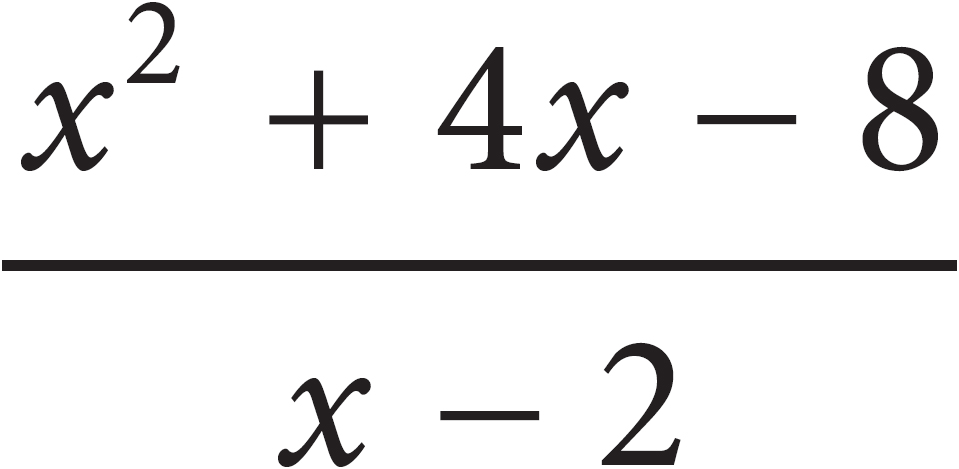 ?
?
A) −3
B) −1
C) 1
D) 3
7. Heinrich must buy at least 100 shares of stock for his portfolio. The shares he buys will be from Stock X, which costs $22 per share and Stock Y, which costs $35 per share. His budget for buying stock is no more than $4,500. He must buy at least 20 shares of Stock X and 15 shares of Stock Y. Which of the following represents the situation described if a is the number of shares of Stock X purchased and b is the number of shares of Stock Y purchased?
A) 22a + 35b ≤ 4,500
a + b ≥ 100
a ≤ 20
b ≤ 15
B) 22a + 35b ≤ 4,500
a + b ≤ 100
a ≤ 20
b ≤ 15
C) 22a + 35b ≤ 4,500
a + b ≤ 100
a ≥ 20
b ≥ 15
D) 22a + 35b ≤ 4,500
a + b ≥ 100
a ≥ 20
b ≥ 15
x2 − 8x + 5
Which of the following is equivalent to the expression above?
A) (x – 4)2 – 11
B) (x – 4)2 + 11
C) (x + 4)2 – 11
D) (x + 4)2 + 11
9. Juliet is selling photographs as part of a project for her entrepreneurship class. She sells the first 20 photographs for $10 each. Because the first 20 photographs sold so quickly, she raised the price of the photographs to $15 each for the rest of the project. After her expenses, Juliet earns a profit of 80% of the revenues from her sales. What is the least number of photographs she must sell for the rest of the project to earn a profit of at least $400 ?
A) 18
B) 20
C) 24
D) 32
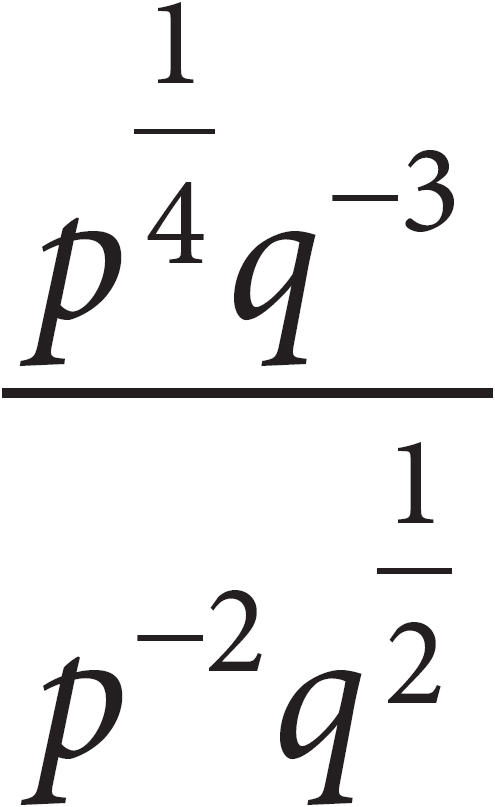
Which of the following is equivalent to the expression above, where p > 1 and q > 1 ?
A) 
B) 
C) 
D) 
11. The graph of function g in the xy-plane is a parabola defined by g(x) = (x − 2)(x − 4). Which of the following intervals contains the x-coordinate of the vertex of the graph?
A) 6 < x < 8
B) 4 < x < 6
C) −2 < x < 4
D) −4 < x < −2
xa3 + ya2 + za = 0
In the equation above, x, y, and z are constants. If the equation has roots −6, 0, and 4, which of the following is a factor of xa3 + ya2 + za ?
A) a – 2
B) a + 4
C) a – 6
D) a + 6
13. If the expression  (x + c)(x – c), where c is a positive constant, can be rewritten as
(x + c)(x – c), where c is a positive constant, can be rewritten as  x2 – 5, what is the value of c ?
x2 – 5, what is the value of c ?
A) 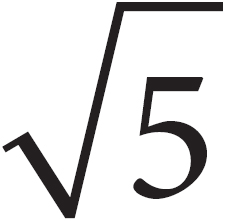
B) 
C) 5
D) 10
14. Which of the following is equivalent to  ?
?
A) z + 5 − 
B) z + 5 − 
C) z + 9 − 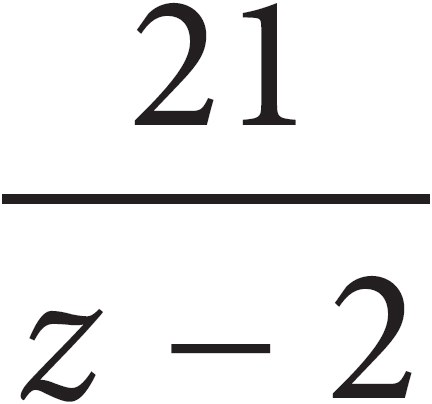
D) z + 9 − 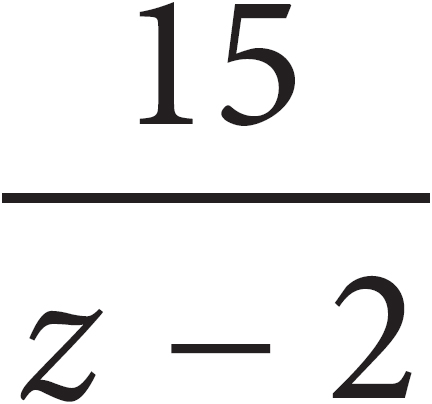
15. A homeowners’ association limits the dimensions of the pools that it will allow in a particular subdivision. The bylaws state that permits will only be granted for pools shaped like rectangular prisms, for which the sum of the length of the pool and the perimeter of the vertical side containing the ladder cannot exceed 200 meters. The perimeter of the ladder side is determined using the width and the depth of the pool. If a pool has a length of 75 meters and its width is 1.5 times its depth, which of the following shows the allowable depth a, in meters, of the pool?
A) 0 < a ≤ 62
B) 0 < a ≤ 50
C) 0 < a ≤ 31
D) 0 < a ≤ 25
DIRECTIONS
For questions 16–20, solve the problem and enter your answer in the grid, as described below, on the answer sheet.
1. Although not required, it is suggested that you write your answer in the boxes at the top of the columns to help you fill in the circles accurately. You will receive credit only if the circles are filled in correctly.
2. Mark no more than one circle in any column.
3. No question has a negative answer.
4. Some problems may have more than one correct answer. In such cases, grid only one answer.
5. Mixed numbers such as 3 must be gridded as 3.5 or 7/2. (If
must be gridded as 3.5 or 7/2. (If  is entered into the grid, it will be interpreted as
is entered into the grid, it will be interpreted as  , not as 3
, not as 3 .)
.)
6. Decimal Answers: If you obtain a decimal answer with more digits than the grid can accommodate, it may be either rounded or truncated, but it must fill the entire grid.

Acceptable ways to grid  are:
are:

Answer: 201 – either position is correct
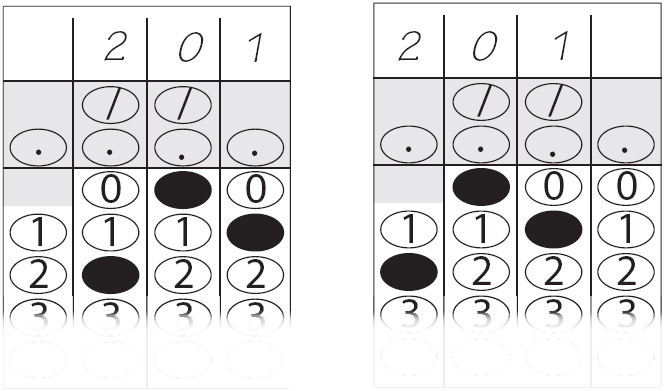
NOTE: You may start your answers in any column, space permitting. Columns you don’t need to use should be left blank.

In the figure above, point D is on line AC, AB = BD = CD, and AD = 15. What is the measure, in degrees, of ∠BCD ? (Disregard the degree symbol when gridding your answer.)
17. If 15 – 3b = 21, what is the value of 5 – b ?
18. The graph of a line in the xy-plane passes through the point (−2, k) and crosses the x-axis at the point (−4, 0). The line crosses the y-axis at the point (0, 12). What is the value of k ?
5(10x2 – 300) + (9844 + 50x2)
The expression above can be rewritten in the form cx2 + d, where c and d are constants. What is the value of d – c ?
20. If n is a constant equal to the number of degrees in an angle measuring 3π radians, what is the value of n ?
S T O P
If you finish before time is called, you may check your work on this section only. Do not turn to any other section in the test.

55 MINUTES, 38 QUESTIONS
Turn to Section 4 of your answer sheet to answer the questions in this section.
DIRECTIONS
For questions 1–30, solve each problem, choose the best answer from the choices provided, and fill in the corresponding circle on your answer sheet. For questions 31–38, solve the problem and enter your answer in the grid on the answer sheet. Please refer to the directions before question 31 on how to enter your answers in the grid. You may use any available space in your test booklet for scratch work.
NOTES
1. The use of a calculator is permitted.
2. All variables and expressions used represent real numbers unless otherwise indicated.
3. Figures provided in this test are drawn to scale unless otherwise indicated.
4. All figures lie in a plane unless otherwise indicated.
5. Unless otherwise indicated, the domain of a given function f is the set of all real numbers x for which f(x) is a real number.
REFERENCE
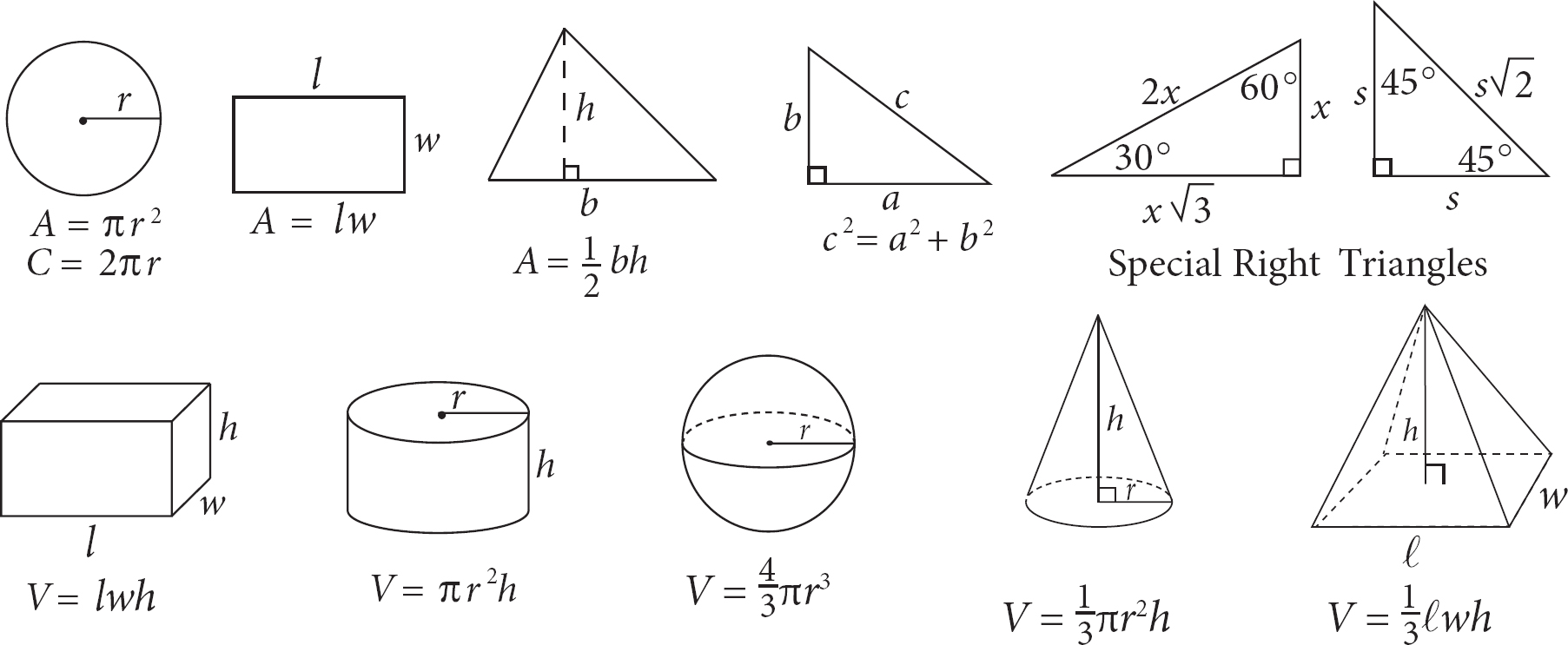
The number of degrees of arc in a circle is 360.
The number of radians of arc in a circle is 2π.
The sum of the measures in degrees of the angles of a triangle is 180.
1. A certain homeowner uses a gas edger to clean up his lawn every time he mows. If the edger uses 160 milliliters of fuel each time, what is the maximum number of times the homeowner can edge his lawn with 8 liters of fuel? (1 liter = 1,000 milliliters)
A) 5
B) 50
C) 100
D) 1,000
Assignment Choice for Two Physics Classes

The table above shows the number of students who chose to be graded on lab reports only or on lab reports and final exams in Dr. Soper’s and Mr. Coelho’s physics classes. What fraction of the students in Dr. Soper’s class chose to be graded on the lab report and final exam?
A) 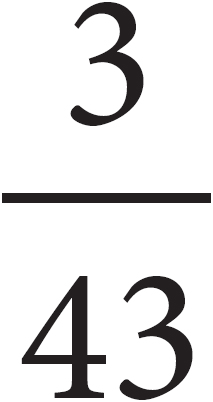
B) 
C) 
D) 
(4 – a2) – (2a2 − 6)
Which of the following expressions is equivalent to the one above?
A) a2 – 2
B) a2 + 10
C) −3a2 – 2
D) −3a2 + 10
4. The ordered pair (3, −1) satisfies which of the following inequalities?
I. x + 3y > 0
II. 2x + 3y > 2
III. x + y < 0
A) I only
B) II only
C) I and III only
D) II and III only
5. A psychology student randomly selected 300 people from a group of people who indicated that they preferred to work alone. Those 300 people were given a task to work on individually and then asked whether they were happy or unhappy while doing the task. Of those surveyed, 5% stated they were unhappy while doing the task. Which of the following inferences can appropriately be drawn from this survey result?
A) Few people who prefer working alone will be unhappy doing this task.
B) Few people who do not prefer working alone will be happy doing this task.
C) Less than 5% of people will be happy doing this task if they do not work alone.
D) Less than 5% of people will be unhappy doing this task if they work alone.

Questions 6 and 7 refer to the following information.

The scatterplot above shows the pH of seven well water samples in West Texas with respect to the bicarbonate concentration in ppm (parts per million). The line of best fit is also shown.
6. According to the scatterplot, which of the following statements about the relationship between a well’s pH and its bicarbonate concentration is true?
A) A well with half as much bicarbonate as another well will have a pH twice that of the other well.
B) Wells that have more bicarbonate tend to have higher pH.
C) Wells that have more bicarbonate tend to have lower pH.
D) The bicarbonate concentration of the well water is unrelated to its pH.
7. A new well is discovered in West Texas with a bicarbonate concentration of 225 ppm. According to the line of best fit, which of the following best approximates the pH of the well water?
A) 7.1
B) 7.3
C) 7.4
D) 8.4

25 = (ky – 1)2
In the equation above, y = −2 is one solution. If k is a constant, what is a possible value of k ?
A) −13
B) −3
C) 0
D) 5
9. Andrew works out for 30 minutes every other day. If he spends 35% of his workout time one day waiting for the weight rack, how many seconds of that day’s workout did he spend waiting for the weight rack?
A) 630
B) 35
C) 21
D) 10.5
10. If 8x – 8yz + 2 = 74, what is the value of x – yz ?
A) 2
B) 6
C) 9
D) 16
11. A chef trimmed fat off a steak and was left with a steak weighing 8.80 ounces. If the weight of the fat was equal to 12 percent of the original weight, what was the original weight, in ounces, of the steak?
A) 8.92
B) 9.20
C) 10.00
D) 11.20
12. A backpacker is packing survival rations that consist of granola bars and packets of peanut butter. A granola bar has 470 food calories, and a packet of peanut butter has 90 food calories. The backpacker makes the survival rations using a total of 10 granola bars and packets of peanut butter combined, and the granola bars and packets of peanut butter have a total of 1,660 food calories. Which of the following systems of equations can be used to determine the number of granola bars, g, and packets of peanut butter, p, that are in the survival rations?
A) 280(g + p) = 1,660
g – p = 10
B) 90g + 470p = 1,660
g – p = 10
C) 90g + 470p = 1,660
g = 10 – p
D) 470g + 90p = 1,660
g = 10 – p
13. Ten floorboards with equal widths laid down side-to-side cover a width of approximately 7 feet. At this rate, which of the following is the closest to the number of boards laid side-to-side needed to cover a width of 32 feet?
feet. At this rate, which of the following is the closest to the number of boards laid side-to-side needed to cover a width of 32 feet?
A) 15
B) 20
C) 30
D) 40
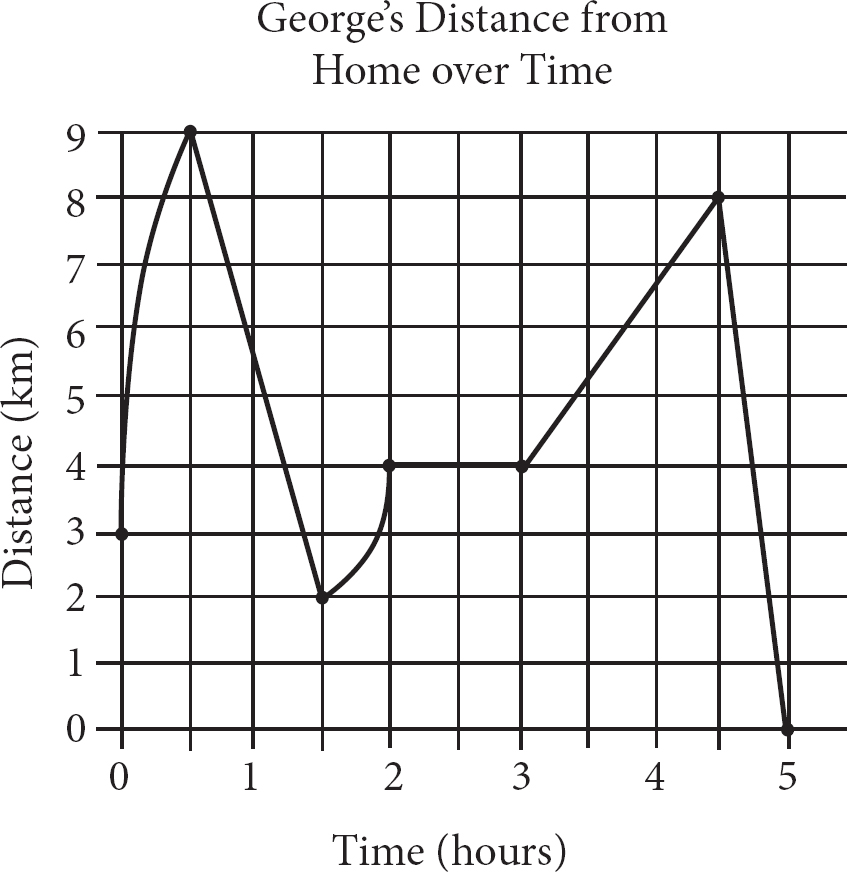
George recorded his distance from home over a five-hour period; his distance and time are shown in the graph above. According to the graph, which of the following is NOT true about the five-hour period?
A) George’s distance from home increased at a constant rate during the first hour of the five-hour period.
B) George’s distance from home reached its maximum during the first hour.
C) George remained a constant distance from his home for one hour.
D) George was moving further from his home for a longer period of time than he was moving closer to his home.
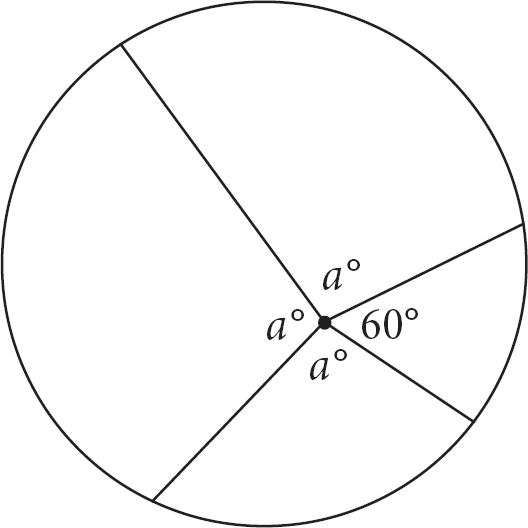
In the figure above, what is the value of a ?
A) 40
B) 60
C) 100
D) 130
y = –75x + 5,000
The equation above models the amount of money y, in dollars, remaining in Bo’s bank account x days after the start of the fall semester. The amount of money in Bo’s bank account is based on the money he earned over the summer and how much he spends per day during the fall semester. When the equation is graphed in the xy-plane, what does the slope of the graph represent in terms of the model?
A) The total amount in Bo’s bank account
B) Daily spending of $5,000
C) Daily spending of $75
D) The amount of money Bo earned over the summer

The scatterplot above shows data for ten accounts opened by a company, along with the line of best fit. For the account that contains the least amount of money, which of the following is closest to the difference of the actual amount and the amount predicted by the line of best fit?
A) $200
B) $500
C) $900
D) $1,200
18. If  = 4 and x + y = 32, what is the value of x – y ?
= 4 and x + y = 32, what is the value of x – y ?
A) −24
B) −8
C) 12
D) 32

The scatterplot above shows the height in centimeters for both the drop and bounce of eight different balls of the same type. The line of best fit for the data is also shown. According to the line of best fit, which of the following is closest to the predicted increase in bounce height, in centimeters, for every increase of 100 centimeters in drop height?
A) 25
B) 20
C) 15
D) 10

Questions 20 and 21 refer to the following information.
Formula A: BMI = 
Formula B: BMI = 
The formulas above are used in nutrition to estimate the body mass index BMI, in kilograms per square meter, of adults whose weight w ranges between 50 and 100 kilograms and whose height h is measured in meters.
20. Based on Formula B, what is w in terms of BMI ?
A) w = 5BMI + 25
B) w = 5BMI – 25
C) w = 
D) w = 
21. If both Formulas A and B give the same estimate for BMI, which of the following expressions is equivalent to 4w – 100 ?
A) 
B) 
C) 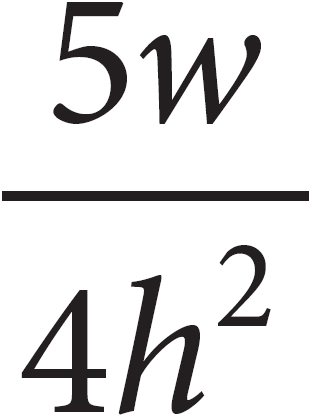
D) 

22. The number of bacteria colonies h hours after the beginning of an experiment is given by the function C(h) = 3h – 2h + 20. What does the number 20 represent in the function?
A) The final rate of growth, in colonies per hour
B) The initial rate of growth, in colonies per hour
C) One less than the initial number of bacteria colonies
D) One more than the final number of bacteria colonies
Agricultural Land as a Percent of Total Land Area, 2014
|
Country |
Percent of Total Land Area |
| Brazil |
33.8% |
| Canada |
7.2% |
| Greenland |
0.6% |
| Latvia |
30.1% |
| Mexico |
54.9% |
| New Zealand |
42.2% |
| Russian Federation |
13.3% |
| Turkey |
50.1% |
| United States |
44.6% |
The World Bank measures the amount of land devoted to agriculture among all 196 countries in the world. The results from 9 of the countries are given in the table above. The median percent of agricultural land for all 196 countries is 34.95%. What is the difference between the median percent of agricultural land for these 9 countries and the median for all 196 countries?
A) 1.15%
B) 4.19%
C) 9.65%
D) 19.95%
24. To ship figurines, the figurines are placed in a rectangular box and then small packing pellets are added. The base of the box has an area of 4.4 in2, and the height of the box is 6.5 in. If the volume of the air in the box after the figures and pellets are added is 8.0 in3, which of the following is closest to the combined volume of the figurines and pellets in the box?
A) 1.9 in3
B) 20.6 in3
C) 28.6 in3
D) 117.84 in3
25. The economy of Argentina as measured by its Gross Domestic Product (GDP) is shrinking at a rate of 2.6% per year. In 2015, the GPD of Argentina was $630 billion. Which of the following functions represents Argentina’s GPD, A, in billions of dollars, y years since 2015 ?
A) A(y) = 630 – (1 – 0.26)y
B) A(y) = 630(1 – 0.26)y
C) A(y) = 630 – (1 – 0.026)y
D) A(y) = 630(1 – 0.026)y

Questions 26 and 27 refer to the following information.
Weights of Modern U.S. Coins
| Coin |
Grams |
Drams |
| Penny |
2.50 |
1.41 |
| Nickel |
5.00 |
2.82 |
| Dime |
2.25 |
1.27 |
The table above gives the average weight, expressed in both grams and drams, of three types of modern U.S. coins.
26. If y grams is equivalent to d drams, of the following, which best represents the relationship between y and d ?
A) y = 1.8d
B) d = 1.8y
C) yd = 1.8
D) y = 0.56d
27. If a bag of coins weighing 225 grams is filled with p pennies, n nickels, and d dimes, which of the following expresses d in terms of n and p ?
A) 100 −  (p + 2n)
(p + 2n)
B) 100 +  (p + 2n)
(p + 2n)
C) 100 −  (p − 2n)
(p − 2n)
D) 100 +  (p − 2n)
(p − 2n)

(x – 2)2 + (y + 5)2 = 36
If a circle in the xy-plane has the equation above, which of the following does NOT lie on the exterior of the circle?
A) (2, 1)
B) (2, 5)
C) (5, 2)
D) (−1, 1)
| Month |
Number of Peppers |
| June |
2,200 |
| July |
2,640 |
A farmer counted the number of peppers produced by a certain field in June and July. The number counted for each month was recorded in the table above. The farmer estimates that the percent increase from June to July would be half the percent increase from July to August. How many peppers does the farmer expect the field to produce in August?
A) 2,860
B) 2,904
C) 3,520
D) 3,696

In the xy-plane above, a point (not shown) with coordinates (a, b) lies on the graph of the linear function h. If a and b are nonzero integers, what is the ratio of b to a ?
A) −4 to 1
B) −2 to 1
C) −1 to 2
D) −1 to 4
DIRECTIONS
For questions 31–38, solve the problem and enter your answer in the grid, as described below, on the answer sheet.
1. Although not required, it is suggested that you write your answer in the boxes at the top of the columns to help you fill in the circles accurately. You will receive credit only if the circles are filled in correctly.
2. Mark no more than one circle in any column.
3. No question has a negative answer.
4. Some problems may have more than one correct answer. In such cases, grid only one answer.
5. Mixed numbers such as 3 must be gridded as 3.5 or 7/2. (If
must be gridded as 3.5 or 7/2. (If  is entered into the grid, it will be interpreted as
is entered into the grid, it will be interpreted as  , not as 3
, not as 3 .)
.)
6. Decimal Answers: If you obtain a decimal answer with more digits than the grid can accommodate, it may be either rounded or truncated, but it must fill the entire grid.

Acceptable ways to grid  are:
are:

Answer: 201 – either position is correct
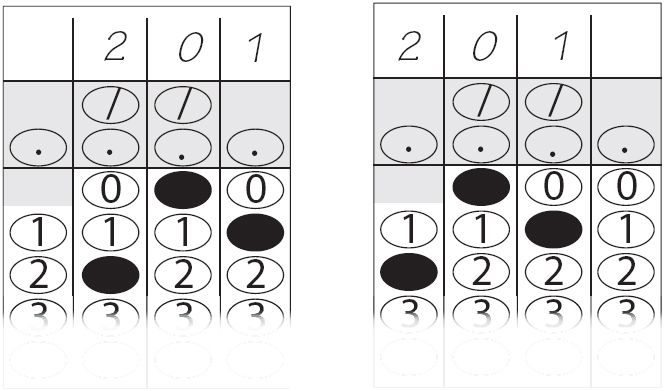
NOTE: You may start your answers in any column, space permitting. Columns you don’t need to use should be left blank.
31. The raw score on a certain standardized test is determined by subtracting  of the number of incorrect answers from the number of correct answers. If a student answered 30 questions and received a raw score of 20, how many questions did the student answer incorrectly?
of the number of incorrect answers from the number of correct answers. If a student answered 30 questions and received a raw score of 20, how many questions did the student answer incorrectly?
32. One of the first diets to limit the intake of carbohydrates was prescribed by Dr. William Harvey in 1862. This diet consisted of three meals a day containing equal amounts of protein per meal. If protein contains 4 dietary calories per gram, and the diet consisted of 672 dietary calories of protein per meal, how much protein, to the nearest ounce, was in each meal? (1 ounce is approximately 28 grams.)
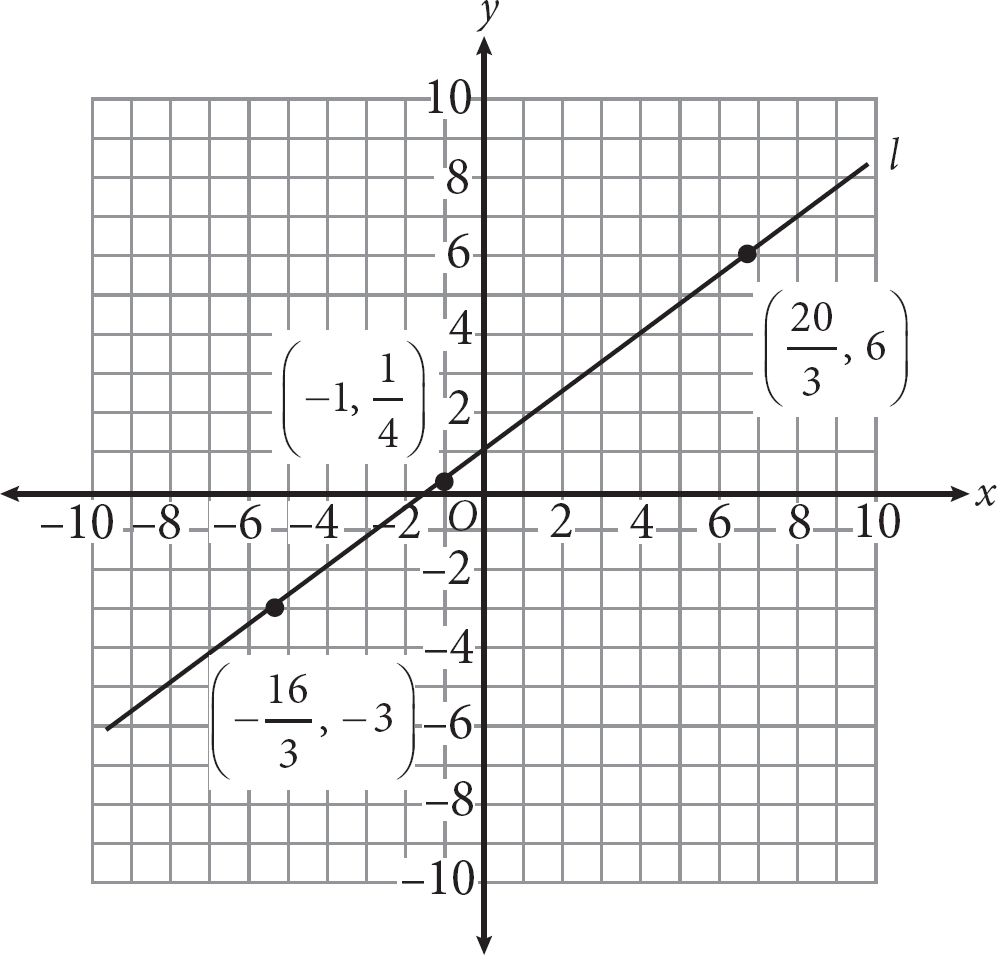
What is the slope of line l shown in the xy-plane above?
–9 – a = b
a2 – 6a – 9 = b
If the ordered pair (a, b) satisfies the system of equations above, what is one possible value of a ?
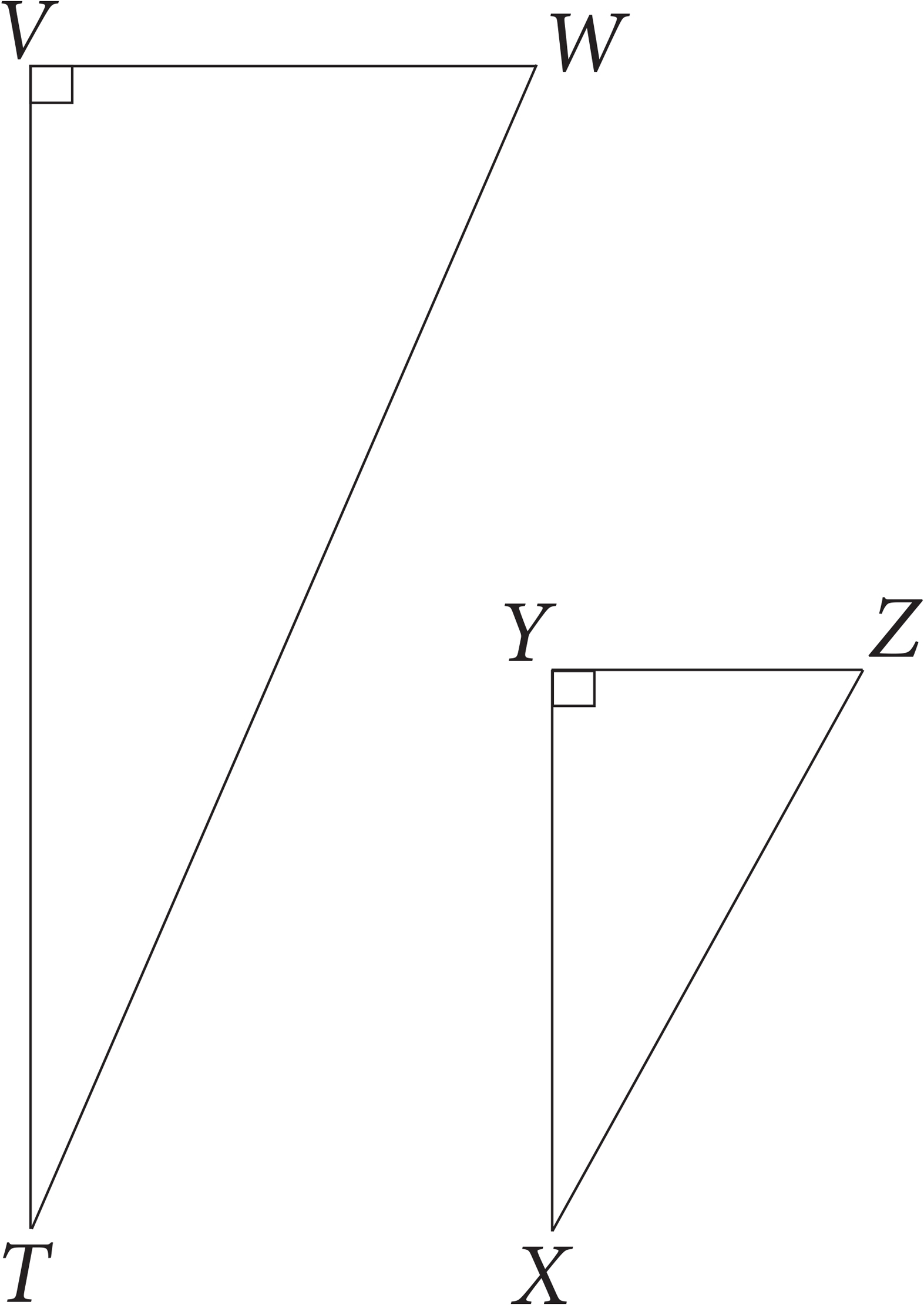
In the figure above, sin T = 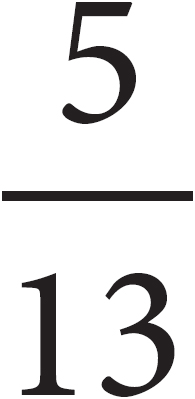 . If TV = 24, XZ = 13, and ∠W ≅ Z , what is VW – YZ ?
. If TV = 24, XZ = 13, and ∠W ≅ Z , what is VW – YZ ?

Point O is the center of the circle above. What fraction of the circumference of the circle is the length of the bolded arc?

Questions 37 and 38 refer to the following information.
Number of Participants by Number of Bullseyes Thrown and Day

The same 15 participants, on each of 3 days, threw 5 darts in order to win a bullseye contest. The number of players throwing a given number of bullseyes on each day is shown in the table above.
37. No participant threw the same number of bullseyes on two different days. If a participant is selected at random, what is the probability that the selected participant threw 3 bullseyes on Day 1 or Day 2, given that the contestant threw 3 bullseyes on one of the three days?
38. What is the mean number of bullseyes each participant threw on Day 2 ?

S T O P
If you finish before time is called, you may check your work on this section only. Do not turn to any other section in the test.